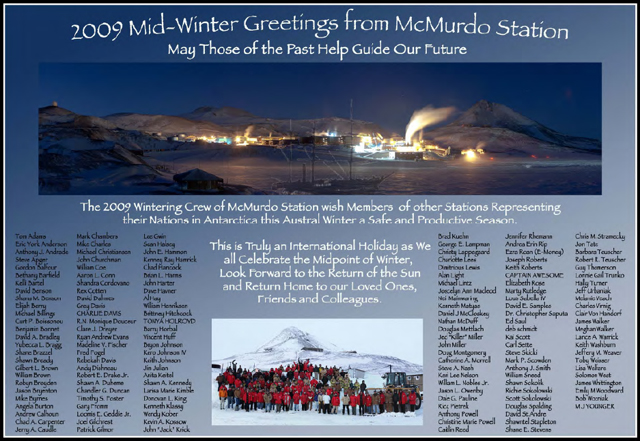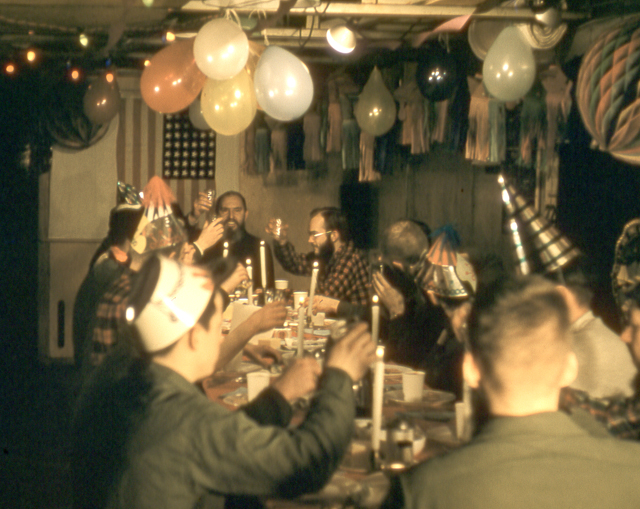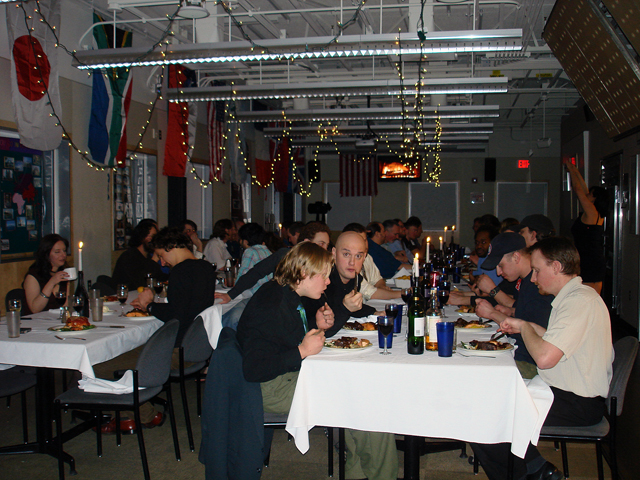Midwinter MomentShortest day of the year a reason to celebrate in AntarcticaPosted July 2, 2009
“We are half-way through our long winter. The sun is circling at its lowest; each day will bring it nearer our horizon. The night is at its blackest; each day will lengthen the pale noon twilight. Until now, the black shadow has been descending on us; after this, day by day, it will rise until the great orb looms above our northern horizon to guide our footsteps over the great trackless wastes of snow. If the light-hearted scenes of to-day can end the first period of our captivity, what room for doubt is there that we shall triumphantly weather the whole term with the same general happiness and contentment?” — Capt. Robert Falcon Scott
The words written by Capt. Scott in 1902 describe the sentiment of the men on Scott’s exploration party as they celebrated the midwinter solstice. This same attitude prevails today for all those who spend the winter season in Antarctica. While the winter solstice takes place on or around June 21 in the southern hemisphere and Dec. 21 in the northern hemisphere, it is not a much-heralded event around the world. Except in Antarctica. Here it has developed into a highly celebrated and often lavish holiday for those who spend the winter on the Ice. The history of the midwinter celebration stretches back as far as Neolithic times. For example, ancient archeological sites such as Stonehenge and New Grange appear aligned with the solar solstice. Midwinter festivals developed feast celebrations as people consumed the last of the fresh food and meat before the deep winter began. More Information
Midwinter festivals may also have developed as therapeutic events for cultures dealing with the darkness of the season. Traditional celebrations involved large fires, illumination, dancing and singing — perhaps winter therapies to combat the malaise brought on by long periods of cold and dark. Midwinter in Antarctica is perhaps the most international of holidays, celebrated equally by people of all nationalities at every station in Antarctica, regardless of politics, national views or religion. Across the continent, messages of greeting and goodwill are sent via e-mail to everyone celebrating the special day. No doubt, many blog about the event to friends, family and readers back home. A century before the digital age, the early explorers kept meticulous records of their expeditions in diaries, including midwinter celebrations. Pretty much everyone writes about the food. While Antarctic living has come a long way from cold, unheated huts and ship cabins, the ability to store food over these long months is still very much the same. Both then and now, the residents of the Antarctic winter survive mostly on canned or frozen meats and vegetables, with little in the way of variety. The Midwinter Dinner has always been a welcome break from the monotony and bleakness of the daily menu. In every journal, blog and diary, there is always a lengthy passage describing the meal in great detail. Scott, in particular, wrote eloquently about the midwinter repast: In 1902: “At six we had our dinner in the wardroom, with the table decorated and the display of all our plate. Starting with turtle soup, we passed on to a generous helping of mutton, and from that to plum pudding, mince pies, and jellies, all washed down with an excellent dry champagne. With a largely assorted dessert of crystallized fruits, almonds and raisins and nuts came the port and liqueurs, which brought us into good form. … With such a dinner we agreed that life in the Antarctic Regions was worth living …” From his fatal 1913 expedition: “At seven o’clock we sat down to an extravagant bill of fare as compared with our usual simple diet. Beginning on seal soup, by common consent the best decoction that our cook produces, we went on to roast beef with Yorkshire pudding, fried potatoes and Brussel sprouts. Then following a flaming plum-pudding and excellent mince pies, and thereafter a dainty savoury of anchovy and cod’s roe.” Many journals include such an exact listing of the menu, with many exotic and unusual (and now illegal) dishes, such as the Pingouin a la Terre Adélie (Adélie Penguin) listed in Douglas Mawson’s account in The Home of the Blizzard. The dinner this year at McMurdo Station Along with a lavish feast, midwinter celebrations across the years and the continent have included music, plays and other forms of revelry. From the Age of Exploration to the early days the U.S. Antarctic Program While co-ed research stations are the norm today, even in winter, the celebrations still reflect the history and tradition of years past. Costumes and skits still prevail in many of the station celebrations, although now there is less need for cross-dressing. In a more modern twist to the celebration, many station events feature homegrown rock bands and dance parties. Marking the inevitable and anticipated return of the sun upon the horizon and the dawning of a new season, midwinter brings with it a feeling of hope and a renewed sense of purpose and possibility. And no matter what changes come with the passing of time and the rise of new technology, many of the hardships remain the same — as well as the traditions that we carry on from expedition to expedition, station to station, and generation to generation. |



For USAP Participants |
For The Public |
For Researchers and EducatorsContact UsU.S. National Science FoundationOffice of Polar Programs Geosciences Directorate 2415 Eisenhower Avenue, Suite W7100 Alexandria, VA 22314 Sign up for the NSF Office of Polar Programs newsletter and events. Feedback Form |




